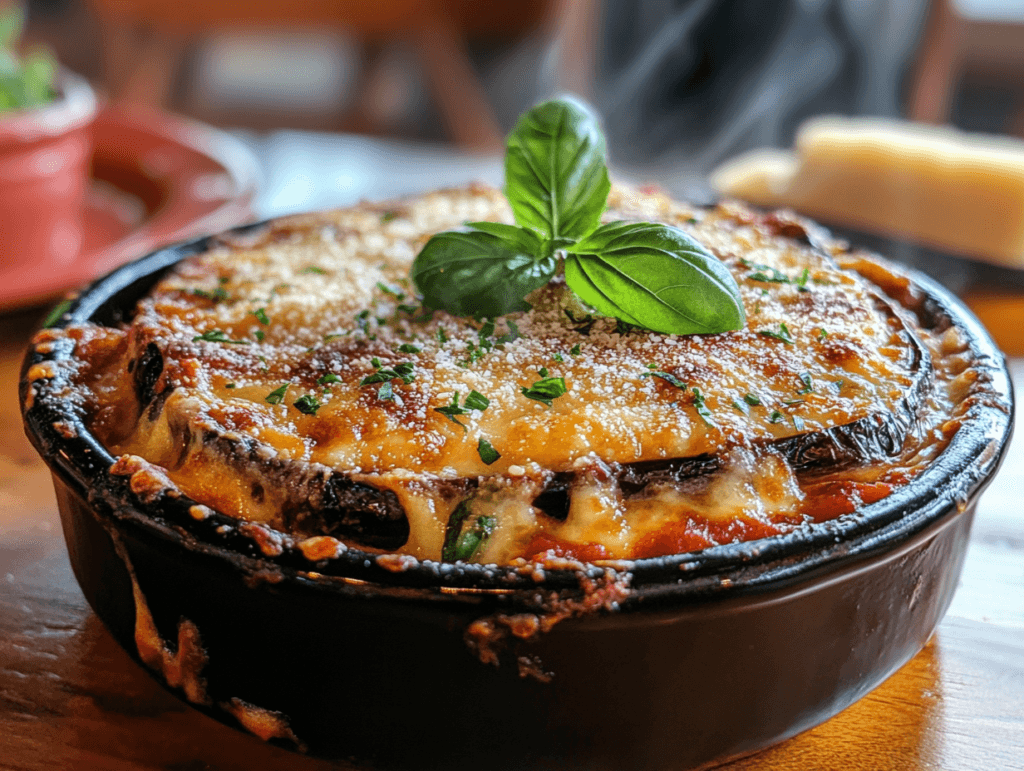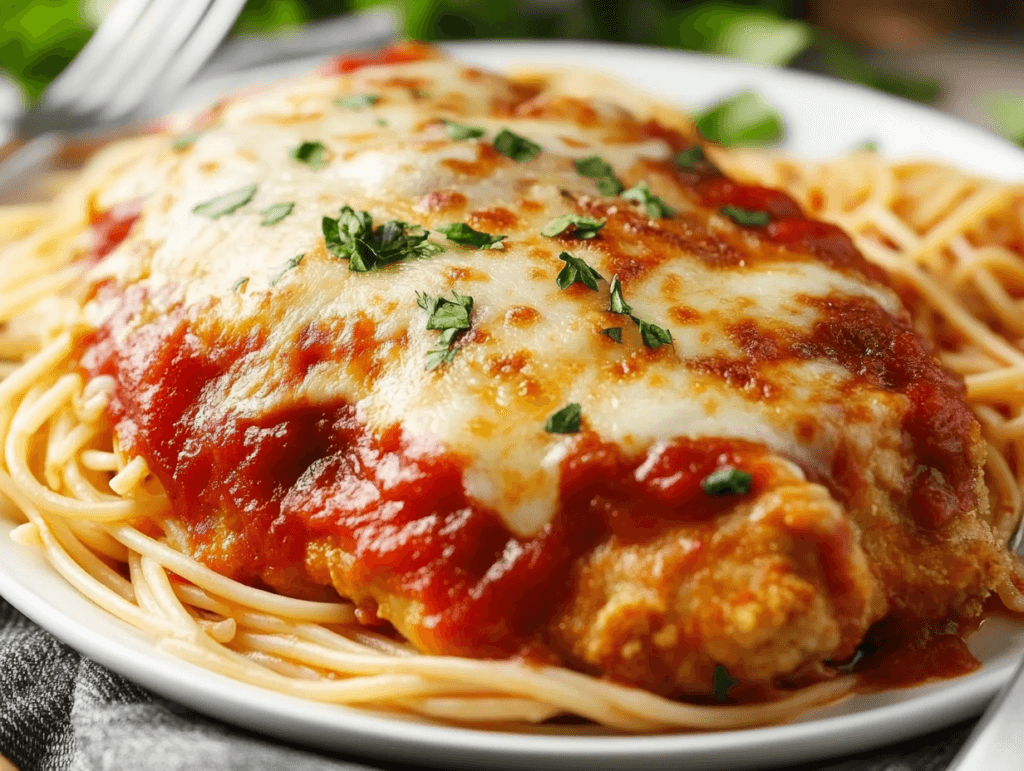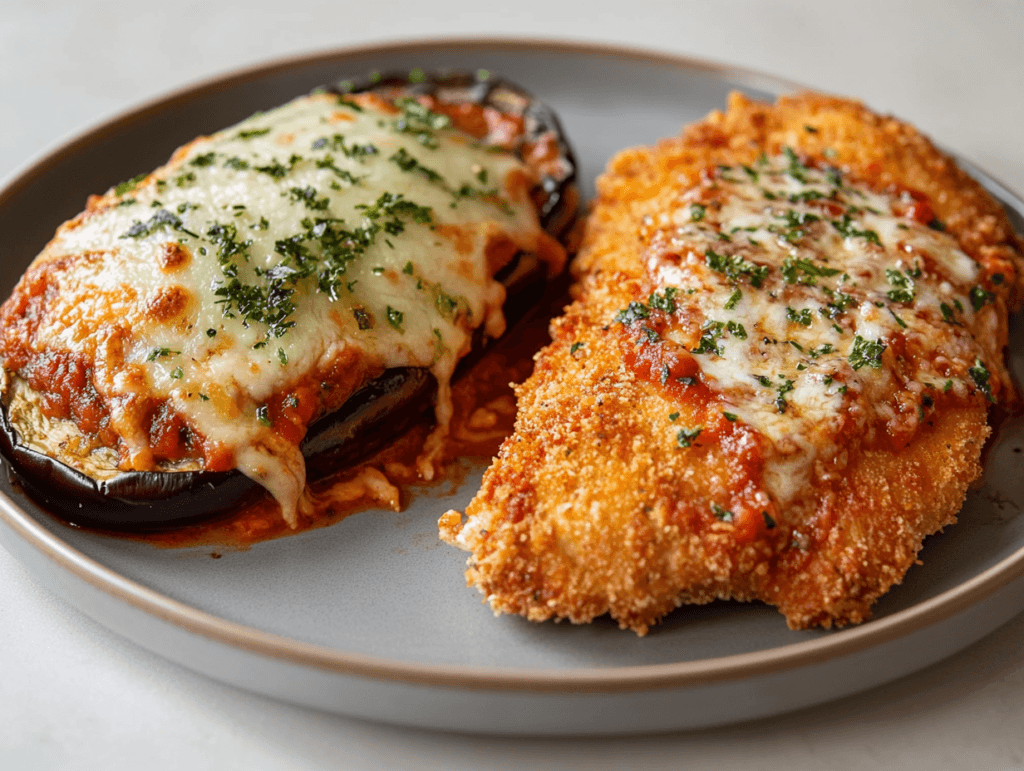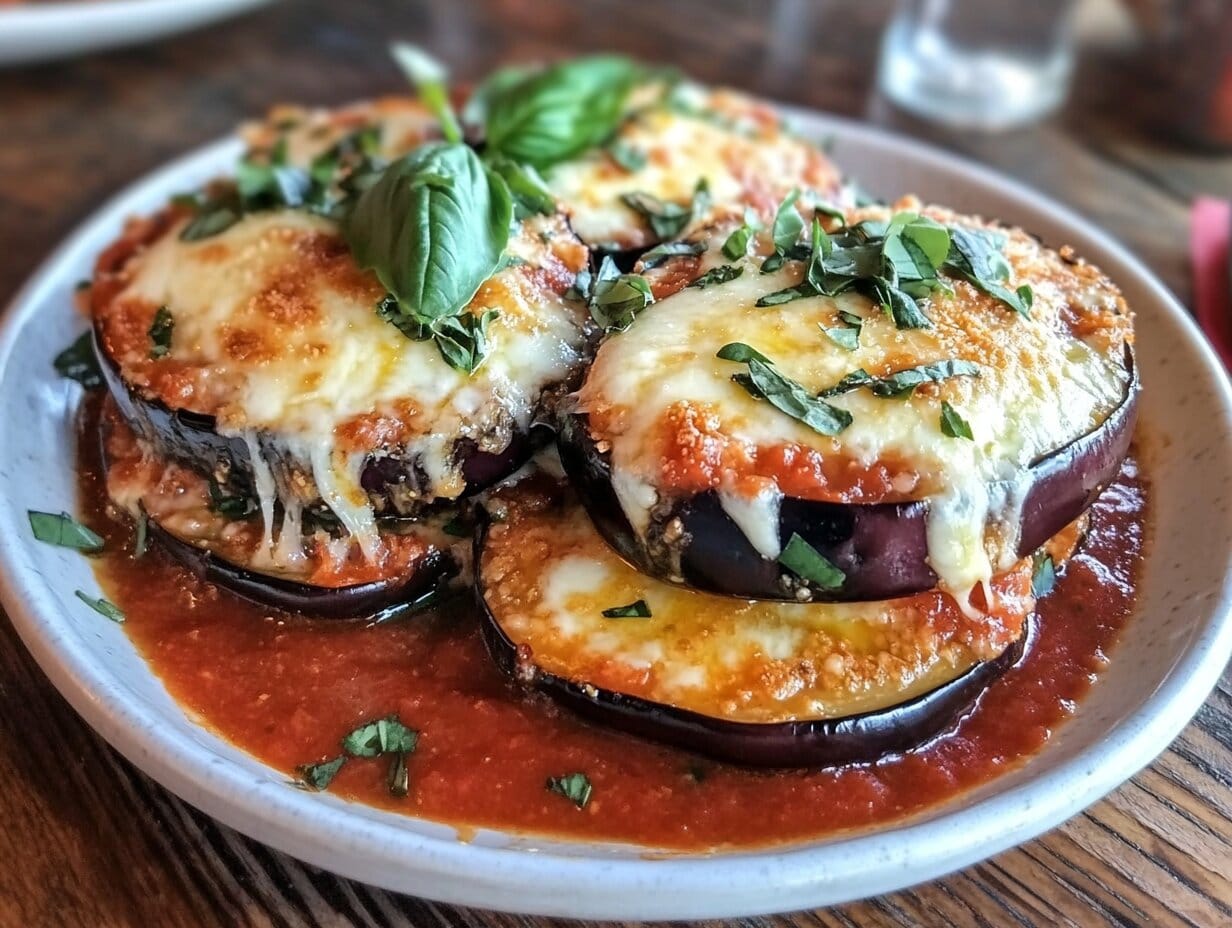When it comes to Italian comfort food, both eggplant Parmigiana and chicken Parmigiana reign supreme. These cheesy, saucy dishes have won the hearts (and stomachs) of food lovers worldwide. But have you ever wondered what truly sets these two apart? Are they cousins, siblings, or distant relatives on the culinary family tree? Let’s dive into the world of these Parmigiana delights and uncover the key differences, similarities, and more.
When deciding on a classic Italian dish, you may wonder about Eggplant vs. Chicken Parm—which one suits your taste or occasion better? Both are iconic in their own right, but understanding their differences will help you choose your next indulgent meal.
Origins of Parmigiana: A Classic Italian Delight
The history of eggplant vs. chicken Parmigiana is as rich and layered as the dishes themselves. Parmigiana is believed to have originated in southern Italy, with regions like Sicily and Campania claiming to be its birthplace. Eggplant was the original star of the recipe, as it was a staple ingredient in Italian cooking due to its abundance and versatility. However, when Italian immigrants brought their culinary traditions to America, chicken became a popular alternative, adapting the dish to suit local tastes.
Whether you choose eggplant vs. chicken Parmigiana, both versions embody the heart of Italian comfort food, celebrating bold flavors and hearty textures that make every bite unforgettable.
Why Are Parmigiana Recipes So Popular?
What’s not to love? Parmigiana dishes are a medley of crispy, savory, and creamy textures, all baked into one glorious creation. They’re versatile too—perfect as a hearty main course, a satisfying leftover, or even a sneaky midnight snack. Add to that the nostalgic charm of Italian family dinners, and you have a dish that’s impossible to resist.
What is Eggplant Parmigiana?

Eggplant Parmigiana, or Melanzane alla Parmigiana in Italian, is a celebration of simplicity and flavor. This vegetarian delight has been a staple in Italian households for centuries.
Key Ingredients of Eggplant Parmigiana
Eggplant Parmigiana starts with—you guessed it—eggplants. They’re the star of the show, but they need some stellar supporting ingredients:
- Eggplants: Typically sliced thin and salted to remove excess moisture.
- Tomato Sauce: A rich and tangy base, often made with garlic, onions, and basil.
- Mozzarella and Parmesan Cheeses: The gooey and nutty components that tie everything together.
- Breadcrumbs: Lightly seasoned for that perfect crunch.
This dish stays true to the essence of vegetarian cuisine while packing a punch of flavor.
Traditional Preparation Methods
Making eggplant Parmigiana is all about the layers. First, the eggplant slices are breaded and fried to golden perfection. Then, they’re layered in a baking dish with tomato sauce and cheese, much like assembling a lasagna. The final bake melds the flavors into a cheesy, bubbling masterpiece.
Flavor Profile and Serving Suggestions
Eggplant Parmigiana has a mild, slightly earthy flavor thanks to the eggplant, balanced by the tanginess of tomato sauce and the creaminess of the cheese. It’s often served with a side of crusty bread or a fresh green salad to round out the meal.
What is Chicken Parmigiana?

Chicken Parmigiana, or Pollo alla Parmigiana, takes the concept of breaded, cheesy deliciousness and introduces juicy chicken cutlets as the base. This American-Italian classic has become a household favorite worldwide.
Key Ingredients of Chicken Parmigiana
While it shares some similarities with its eggplant counterpart, chicken Parmigiana introduces its own twist:
- Chicken Breasts: Typically pounded thin for even cooking.
- Tomato Sauce: Rich and tangy, much like the version used in eggplant Parmigiana.
- Mozzarella and Parmesan Cheeses: Melted to golden perfection.
- Breadcrumbs: For that irresistible crispy coating.
Some versions even include a touch of Italian seasoning or fresh herbs to amplify the flavor.
Traditional Preparation Methods
The preparation starts by coating chicken breasts in breadcrumbs, frying them until golden, and then layering them with sauce and cheese in a baking dish. The final step? A trip to the oven until the cheese is melted and slightly browned.
Flavor Profile and Serving Suggestions
Chicken Parmigiana delivers a heartier flavor compared to its eggplant sibling. The tender, juicy chicken pairs beautifully with the tangy tomato sauce and creamy cheese. It’s often served with pasta, making it a more filling option for those seeking a robust meal.
For more dinner inspiration, check out the Ultimate Guide to Baked Chicken Cutlets.
Comparing Eggplant Parmigiana and Chicken Parmigiana

The debate of Eggplant vs. Chicken Parm isn’t just about ingredients; it’s about texture, flavor, and even cultural significance. Eggplant offers a vegetarian-friendly option with a creamy bite, while chicken delivers a heartier, meaty profile.
Differences in Ingredients
The obvious difference is the main ingredient. Eggplant offers a vegetarian option that feels lighter, while chicken brings a protein-packed punch to the table.
Variations in Cooking Techniques
Eggplant requires salting and drying to remove bitterness, while chicken is all about achieving that golden, crispy exterior. The methods may differ, but the end goal is the same: layers of irresistible flavor.
Nutritional Comparison: Which Is Healthier?
If you’re watching your calories, eggplant Parmigiana is the lighter choice. Eggplant is naturally lower in fat and calories, whereas chicken provides more protein but can be heavier when fried. For a healthier twist, both dishes can be baked instead of fried.
H3: Flavor and Texture Differences
A key point in the Eggplant vs. Chicken Parm discussion is the contrast in texture. Eggplant provides a softer, melt-in-your-mouth consistency, while chicken adds a satisfying chewiness that pairs beautifully with melted cheese and tomato sauce.
Common Problems When Making Parmigiana Dishes
As delicious as eggplant Parmigiana and chicken Parmigiana are, they can be a bit tricky to perfect. From soggy layers to uneven seasoning, a few common pitfalls can turn your culinary masterpiece into a disappointment. But don’t worry—we’ve got you covered with solutions to ensure your Parmigiana is always top-notch.
Soggy Layers: How to Avoid It?
Nobody likes a soggy Parmigiana. Whether it’s the eggplant or the chicken, excess moisture can ruin the dish’s texture.
For Eggplant Parmigiana:
- Salt the eggplant slices before cooking. This draws out moisture and reduces bitterness.
- Use a clean towel or paper towels to pat the slices dry before breading.
- Fry or bake the eggplant slices until they’re golden and slightly crispy to maintain their structure.
For Chicken Parmigiana:
- Pound the chicken breasts to an even thickness for consistent cooking.
- Avoid overloading the pan when frying. Crowding can cause steam, leading to soggy breading.
Balancing Flavors with Tomato Sauce and Cheese
Too much sauce can overwhelm the dish, while too little can make it dry. Achieving balance is key.
- Use a flavorful, well-seasoned tomato sauce. A pinch of sugar can cut through acidity if the sauce feels too tangy.
- Layer the sauce and cheese evenly to ensure every bite delivers the perfect harmony of flavors.
Pro tip: Use freshly grated Parmesan for an extra burst of umami flavor. Store-bought grated cheese often lacks the same depth.
Breaded Layers Falling Apart
One common frustration is when the breading detaches from the eggplant or chicken.
- Ensure your eggplant slices or chicken cutlets are dry before breading.
- Double-dip for extra stickiness: coat with flour first, then egg, and finally breadcrumbs.
- Let the breaded pieces rest for a few minutes before frying to set the coating.
Creative Twists on Traditional Recipes
Parmigiana is a classic, but who says you can’t add your own flair? With a little creativity, you can transform these traditional recipes into something entirely new while still preserving their charm.
Vegan and Vegetarian Alternatives
Eggplant Parmigiana is already vegetarian, but it can be made vegan with a few simple swaps:
- Replace mozzarella and Parmesan with plant-based cheese alternatives. Cashew-based cheeses work particularly well.
- Opt for almond flour instead of breadcrumbs for a gluten-free and vegan option.
You can even experiment with other vegetables like zucchini or portobello mushrooms as the base for a unique twist.
Gluten-Free Parmigiana Options
For those avoiding gluten, there are plenty of substitutions:
- Use gluten-free breadcrumbs or crushed rice crackers for breading.
- Swap out wheat flour for almond or coconut flour during the breading process.
Bonus tip: Bake instead of frying for a lighter, gluten-free alternative that still retains all the flavor.
Cultural Significance of Eggplant and Chicken Parmigiana
Parmigiana dishes aren’t just about the flavors—they carry deep cultural significance, showcasing how food evolves with history and migration.
Global Adaptations and Regional Variations
While Parmigiana originated in Italy, it has taken on a life of its own across the globe:
- In the United States, chicken Parmigiana often appears as a hearty sandwich or over a bed of spaghetti.
- In Australia, “chicken parma” is a pub classic, sometimes topped with ham for extra indulgence.
- Vegetarian versions using zucchini or pumpkin are popular in parts of Europe.
The Role of Parmigiana in Italian-American Cuisine
Chicken Parmigiana gained popularity in the United States when Italian immigrants adapted their recipes to American tastes. Chicken, being more readily available and affordable than eggplant, became the star. Over time, it became a quintessential Italian-American comfort food.
FAQs About Eggplant and Chicken Parmigiana
Curious about the differences and similarities between eggplant vs. chicken Parmigiana? Here are answers to some common questions to help you understand these delicious dishes better.
Can You Substitute Eggplant for Chicken in Parmigiana?
Yes, you can easily swap eggplant for chicken when making Parmigiana. The recipe works beautifully with either ingredient, though the texture and flavor will differ. Eggplant brings a soft, silky feel, while chicken adds a hearty, meaty bite. Whichever you choose, the essence of eggplant vs. chicken Parmigiana remains intact.
Which Is Healthier: Eggplant or Chicken Parmigiana?
When comparing eggplant vs. chicken Parmigiana, eggplant tends to be lighter in calories and fat, especially if baked instead of fried. Chicken Parmigiana, on the other hand, provides more protein and may be more filling. The healthier choice depends on how the dish is prepared and your nutritional goals.
What’s the Best Way to Reheat Parmigiana?
For both eggplant vs. chicken Parmigiana, the best reheating method is in the oven. Preheat the oven to 350°F (175°C), place the dish on a baking sheet, and heat for 15–20 minutes. This keeps the layers crispy and the cheese perfectly melty. Avoid microwaving, as it can make the breading soggy.
Do Eggplant and Chicken Parmigiana Have the Same Origins?
The origins of eggplant vs. chicken Parmigiana differ slightly. Eggplant Parmigiana hails from southern Italy, where eggplant was a widely available and popular ingredient. Chicken Parmigiana, however, became an Italian-American adaptation, bringing a heartier twist to the classic recipe.
Can You Make Parmigiana Without Frying?
Absolutely! Both eggplant vs. chicken Parmigiana can be baked or air-fried for a healthier alternative. Baking reduces oil content while maintaining the crispiness and flavor that makes Parmigiana so irresistible.
Why Is Eggplant Sometimes Bitter in Parmigiana?
Bitter eggplant can impact the flavor of eggplant Parmigiana. To avoid this, salt the eggplant slices before cooking to draw out excess moisture and reduce bitterness. This step ensures a sweeter, smoother taste that pairs beautifully with the tomato sauce and cheese
Which is more versatile, Eggplant vs. Chicken Parm?
Both are versatile but cater to different preferences. Eggplant is ideal for vegetarian dishes, while chicken suits protein-rich diets.
Can you bake both options?
Absolutely! Baking is a great way to make Eggplant vs. Chicken Parm lighter while retaining the signature flavors.
Choosing Between Eggplant Parmigiana and Chicken Parmigiana
When it comes to the timeless debate of eggplant vs. chicken Parmigiana, there’s no wrong choice—only the one that fits your cravings. If you’re in the mood for something lighter and vegetarian-friendly, eggplant Parmigiana delivers a soft, creamy texture with rich, earthy flavors. On the other hand, chicken Parmigiana offers a heartier, protein-packed option with a crispy, juicy bite that’s undeniably satisfying.
No matter which you prefer, both dishes showcase the magic of Italian cuisine: simple ingredients transformed into unforgettable comfort food. The next time you’re deciding between eggplant vs. chicken Parmigiana, let your taste buds guide you—and enjoy every cheesy, saucy bite!

